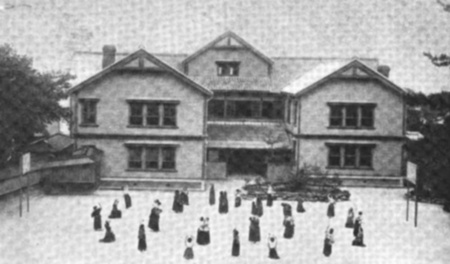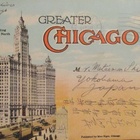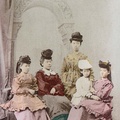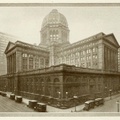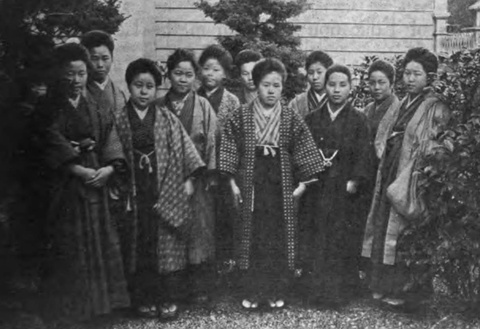
As I continue to uncover the Japanese who came to Chicago before the war, what attracts me the most and inspires me is, without a doubt, the spirit and talent of the Meiji women. Their energy brings to light the wonder of life, colored by encounters, and the richness and beauty of history.
A distinctive feature of the Japanese population in Chicago before the war was the large number of Christians. Shimazu Misaki, who carried out missionary work among the Japanese in Chicago for over 25 years, established the Japanese Christian Church in 1914. However, Buddhist churches did not come into existence until 1944, when an increasing number of people were relocating to Chicago from internment camps. This contrasts sharply with the Buddhist churches that were established in Hawaii in 1894 and San Francisco in 1899.
150 years ago, at the end of March 1873, Japan lifted the ban on Christianity. Just one month later, female missionaries from Chicago left for Japan. Male missionaries had already been to Japan before the lifting of the ban, with Presbyterians active in the Kanto region and Congregationalists active in the Kansai region. Daniel Crosby Greene and Jerome Dean Davis, who graduated from the Congregationalist seminary in Chicago, began evangelism and opened a school in Kobe in 1872. They then invited two female missionaries to Japan through the Woman's Board of Missions of the Interior in order to start educating women.
One of them was Julia Dudley, a native of Naperville, Illinois, who had been educated at Rockford Female Seminary, the alma mater of Jane Addams, the female social welfare activist known for opening the settlement center "Hull House" for the poor in Chicago.
The other was Eliza Talcott from Connecticut. Upon arriving in Kobe, the two gathered 20 girls over the age of eight and started a small private school.
In the town of Evanston, north of Chicago, a movement to support the couple was immediately launched. In May 1874, the Evanston church sent a donation of $120 to Kobe, along with a message asking for letters from Japanese girls studying at the school. They added, "You don't need to translate the letters into English. We have a Japanese boy in our Sunday school who will translate them for you." The Japanese boy was Paulo Sawayama, who had studied English under Green in Kobe and was studying in the preparatory class for Northwestern University. Julia and Eliza's private school became a boarding school called Kobe Home in 1875.
Kobe Home became Kobe Girl's School in 1879, and produced its first class of 12 students in 1882. In 1894, it changed its name to Kobe College, the forerunner of today's prestigious Kobe College.
Meanwhile, Jerome Dean Davis moved from Kobe to Kyoto with his wife Sophia in 1875 to help out at Doshisha English School, which Niijima Jo had opened in the same year. Sophia started a girls' school in Davis' home with three students. The following April, 1876, Alice J. Starkweather was assigned to the school. Starkweather, who had been a teacher in Elgin, a suburb of Chicago, traveled to Japan with Sawayama Paulo and others seeing her off. In 1877, the girls' school officially opened as Doshisha Girls' School, and in 1882, the first class of five students graduated.
After Starkweather returned to the United States in 1883, Mary Ellen Wainwright, who was from Dundee, Illinois, like Sophia, came to Doshisha Girls' School in 1887, followed by Mary Denton from California the following year in 1888. Wainwright was the first missionary with specialized training in music, and Denton was a member of the Southern California branch of the Woman's Christian Temperance Union, headquartered in Evanston, Illinois.
The Women's Christian Temperance Union sent missionary Mary Leavitt to Japan in 1886. Leavitt gave lectures throughout Japan from Tokyo to Nagasaki for almost half a year from June to December, and had a great influence on Japanese Christians. Women who were deeply sympathetic to her message established the Tokyo Women's Temperance Union in Tokyo in December of the same year, with Yajima Kajiko as president and 56 members. Branches were organized throughout the country.
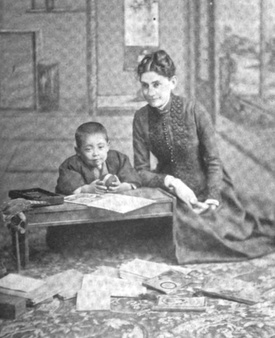
Also in 1886, in Oak Park, Illinois, Annie Howe, a kindergarten teacher who graduated from Rockford Girl's School in 1869, was impressed by a lecture given by Jerome Dean Davis, who had returned to Japan for a short time. The following year, in 1887, the Chicago Women's Board of the Interior sent Annie to Kobe, who had decided to become a missionary. Annie established Shoei Kindergarten in Kobe in 1889, and made a great contribution to early childhood education in Japan for 40 years until she returned to Japan in 1927, calling herself "Jap Annie."
Among the Presbyterian women missionaries active in the Kanto region was the first and last female missionary doctor sent to Japan by the Woman's Presbyterian Board of the Missions of the Northwest in 1883. She was Sarah K. Cummings, a graduate of the Woman's Medical College of Chicago. The Presbyterian Kanazawa Station where Sarah was assigned was established in 1879 by Rev. Thomas Winn, a native of Galesburg, Illinois, who had graduated from the Presbyterian Theological Seminary of the Northwest. His wife Lila was also from Galesburg.
In this way, various missionaries from Illinois expanded their networks to every corner of Japan, and led ambitious Japanese women who were searching for new ways of life for women in Meiji Japan to Chicago.
© 2023 Takako Day


